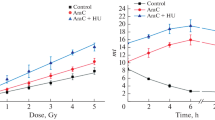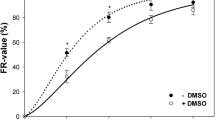Aims:
To examine the dose response of DNA damage and its modification by the radiosensitizer, 5-bromo-2'-deoxyuridine (BrdU). The sensitizing mechanism is analyzed with regard to its influence on the induction and repair of DNA double-strand breaks (DSBs).
Material and Methods: Cells from three different human glioblastoma lines, A7, LH and U87MG, were X-irradiated with and without exposure to BrdU. DNA fragments were separated by field-inversion gel electrophoresis (FIGE) and quantified by fluorometry immediately and 24 h after irradiation.
Results: In all cell lines, the dose response followed a linear-quadratic rather than a purely linear function. BrdU-treated cells exhibited a significantly higher amount of mobile DNA. In repair experiments with and without BrdU, the amount of mobile DNA fell close to control values within 24 h.
Conclusions: The linear-quadratic model appropriately describes the X-ray-induced fragmentation of DNA. BrdU sensitizing acts predominantly by increasing DNA fragility, and not by impairing damage repair. The amount of DSBs persistent after 24 h of repair is minimal, even after highly cytotoxic doses. However, it appears to depend on the extent of initial damage, causing sensitized cells to retain more DSBs than unsensitized cells.
Ziel:
Bestimmung der Dosis-Wirkungs-Beziehung zwischen ionisierender Strahlung und DNA-Doppelstrangbrüchen (DSBs). Modulation der Schädigung durch den Strahlensensitizer 5-Brom-2'-desoxyuridin (BrdU). Analyse des Wirkmechanismus von BrdU im Hinblick auf Induktion und Reparatur von DSBs.
Material und Methode: Drei menschliche Glioblastomzelllinien, A7, LH und U87MG, wurden mit und ohne BrdU-Vorbehandlung röntgenbestrahlt. Die unmittelbar nach Exposition bzw. nach daran anschließender 24-stündiger Reparaturzeit vorliegenden DNA-Fragmente wurden mit der Feld-Inversions-Gelelektrophorese (FIGE) aufgetrennt und fluorometrisch quantifiziert.
Ergebnisse: In allen Zelllinien folgt die Dosis-Wirkungs-Beziehung eher einen linear-quadratischen als einer rein linearen Funktion. BrdU-behandelte Zellen zeigten vermehrt mobile DNA. Während des 24-stündigen Reparaturintervalls ging die Menge mobiler DNA mit und ohne Sensibilisierung nahezu auf Kontrollwerte zurück.
Schlussfolgerungen: Das linearquadratische Modell beschreibt in geeigneter Weise die durch Röntgenstrahlen verursachte DNA-Fragmentierung. Die Sensibilisierung dur BrdU erfolgt vorzugsweise durch Erhöhung der Bruchanfälligkeit der DNA, jedoch kaum durch Inhibition der DNA-Reparatur. Die Menge der nach 24-stündiger Reparatur fortbestehenden DSBs scheint vom Umfang der initialen Schäden abzuhängen, so dass nach Sensitizing leicht vermehrt Stranbrüche persistieren.
Similar content being viewed by others
Author information
Authors and Affiliations
Additional information
Received: January 10, 2002; accepted: June 19, 2002
Rights and permissions
About this article
Cite this article
Nusser, N., Bartkowiak, D. & Röttinger, E. The Influence of Bromodeoxyuridine on the Induction and Repair of DNA Double-Strand Breaks in Glioblastoma Cells. Strahlenther Onkol 178, 504–509 (2002). https://doi.org/10.1007/s00066-002-0991-y
Issue Date:
DOI: https://doi.org/10.1007/s00066-002-0991-y




